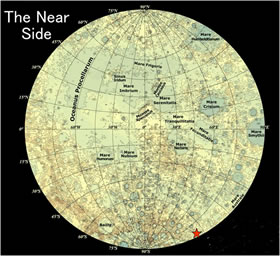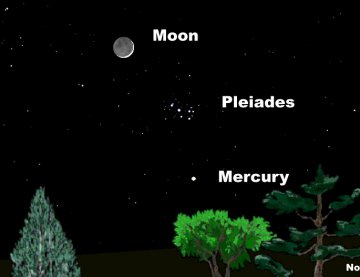
Various Space Stuff
Started by cousin it, Jan 12 2009 04:11 PM
81 replies to this topic
#33

Posted 20 February 2009 - 12:09 PM
The comet makes it's closest approach to Earth on the 24th(Tuesday morning) at 38 million miles. It continues to grow in size and brightness.
This image was taken with an "off the shelf" digital camera Tuesday morning(2/17). The bright star is Theta Virginis(4th mag).

From:Spaceweather.com
This image was taken with an "off the shelf" digital camera Tuesday morning(2/17). The bright star is Theta Virginis(4th mag).

From:Spaceweather.com
#34

Posted 23 February 2009 - 02:32 AM
Nice views of the comet tonight. In binocs it is very bright. It reminds me of what a large galaxy would look like in a scope. I'm in a city with a lot of light pollution, and still got some green tint through a pair of 10x50s.
Tonight it is located about 1/2 of a binocular field away from Saturn. Tomorrow Saturn and it will be virtually "touching".
#37

Posted 16 May 2009 - 06:24 AM
This photo has been making the rounds on all the news networks:

Find out what went into capturing this fantastic image at Space Weather

Find out what went into capturing this fantastic image at Space Weather
#39

Posted 27 May 2009 - 05:17 PM
NASA has an article up today explaining the difficulties associated with high energy particles(ionizing radiation), and space travel. The technology for a Lunar base is iffy, and with current technology, Mars is out of the question.
From the article:
"Short lunar missions are fine," Cucinotta says, "but living in a lunar habitat for 6 months starts to be problematic. We're going to have to do a really good job with radiation shielding and perhaps medical countermeasures to have 6-month missions."
Mars will be even tougher, these models suggest. Some scenarios call for missions that would last 18 months or more. "Right now there's no design solution to stay within safety limits for such a Mars mission," Cucinotta says. "Putting enough radiation shielding around a spacecraft would make it far too heavy to launch, so we need to find better lightweight shielding materials, and we probably need to develop medical techniques to counteract damage to cells caused by cosmic rays." He notes that one of the biggest obstacles to progress in this area is "uncertainty in the types of cell damage deep cosmic ray exposure can cause. We still have a lot to learn."
http://science.nasa....hantomtorso.htm
From the article:
"Short lunar missions are fine," Cucinotta says, "but living in a lunar habitat for 6 months starts to be problematic. We're going to have to do a really good job with radiation shielding and perhaps medical countermeasures to have 6-month missions."
Mars will be even tougher, these models suggest. Some scenarios call for missions that would last 18 months or more. "Right now there's no design solution to stay within safety limits for such a Mars mission," Cucinotta says. "Putting enough radiation shielding around a spacecraft would make it far too heavy to launch, so we need to find better lightweight shielding materials, and we probably need to develop medical techniques to counteract damage to cells caused by cosmic rays." He notes that one of the biggest obstacles to progress in this area is "uncertainty in the types of cell damage deep cosmic ray exposure can cause. We still have a lot to learn."
http://science.nasa....hantomtorso.htm
#42

Posted 07 June 2009 - 12:57 PM
Japan's Kaguya space craft has reached the end of its operational life. It will be crashed into the surface of the Moon in a controlled impact. These types of events had been observable, in the past, with small telescopes or binoculars(though, I don't know if this one will). So, if you are not doing anything Wed. night at 22:30 eastern, look up.
From the Selene release:

Expected KAGUYA impact point
The Japan's lunar explorer "KAGUYA", which is now in the extended operational phase, has been carrying out observations of the Moon from lower altitude since February 1, 2009, to continue observations in more detail.
The "KAGUYA" will conclude its scientific mission to the Moon through a controlled impact on the lunar surface.
Expected impact date
18:30, June 10, 2009 (GMT) Near side, night time area
Expected impact location
E80, S63
Lunar phase & age on impact date
17.3 (London)
Lunar age quotation : NAOJ - Koyomi Station
Impact information may be updated because of the latest orbit determination and/or satellite status. The newly information will be posted on SELENE project homepage.
As for the new schedule announcement is planned at June 10, at 1 a.m. (GMT).
SELENE Project homepage : http://www.kaguya.jaxa.jp/index_e.htm
From the Selene release:

Expected KAGUYA impact point
The Japan's lunar explorer "KAGUYA", which is now in the extended operational phase, has been carrying out observations of the Moon from lower altitude since February 1, 2009, to continue observations in more detail.
The "KAGUYA" will conclude its scientific mission to the Moon through a controlled impact on the lunar surface.
Expected impact date
18:30, June 10, 2009 (GMT) Near side, night time area
Expected impact location
E80, S63
Lunar phase & age on impact date
17.3 (London)
Lunar age quotation : NAOJ - Koyomi Station
Impact information may be updated because of the latest orbit determination and/or satellite status. The newly information will be posted on SELENE project homepage.
As for the new schedule announcement is planned at June 10, at 1 a.m. (GMT).
SELENE Project homepage : http://www.kaguya.jaxa.jp/index_e.htm
#43

Posted 08 June 2009 - 07:01 PM
A Real Whopper: Black Hole Is Most Massive Known
SPACE.com
Andrea Thompson
PASADENA, CALIF. — The most massive black hole yet weighed lurks at the heart of the relatively nearby giant galaxy M87.
The supermassive black hole is two to three times heftier than previously thought, a new model showed, weighing in at a whopping 6.4 billion times the mass of the sun. The new measure suggests that other black holes in nearby large galaxies could also be much heftier than current measurements suggest, and it could help astronomers solve a longstanding puzzle about galaxy development.
"We did not expect it at all," said team member Karl Gebhardt of the University of Texas at Austin.
The discovery was announced here today at the 214th meeting of the American Astronomical Society.
Game changer
The finding "is important for how black holes relate to galaxies," said team member Jens Thomas of the Max Planck Institute for Extraterrestrial Physics in Germany. "If you change the mass of the black hole, you change how the black hole relates to the galaxy."
Because of this relationship, the revised mass could impact astronomers' theories of how galaxies grow and form.
Higher black hole masses could also solve a paradox of the masses of faraway, developing galaxies called quasars. These mysterious denizens of the early universe are very bright, developing galaxies with black holes surrounded by gas and dust, all rife with star formation. Quasars are colossal, around 10 billion solar masses, "but in local galaxies, we never saw black holes that massive, not nearly," Gebhardt said.
"The suspicion was before that the quasar masses were wrong," he said. But "if we increase the mass of M87 two or three times, the problem almost goes away."
Why M87 matters
M87 is 50 million light-years away. Nearly three decades ago, it was one of the first galaxies suggested to harbor a central black hole. Now astronomers think that most large galaxies, including our own Milky Way, have supermassive black holes at their centers.
M87 also has an active jet shooting light out of the galaxy's core, created where matter swirls closer to the black hole and approaches the speed of light, then combines with tremendous magnetic fields. The spat-out material helps astronomers understand how black holes attract and gobble up matter, a sloppy process in which all is not consumed.
These factors make M87 "the anchor for supermassive black hole studies," Gebhardt said.
While the new mass of M87 is based on a model, recent observations from the Gemini North Telescope in Hawaii and the European Southern Observatory's Very Large Telescope in Chile support the model findings.
The study of M87's mass will also be detailed later this summer in the journal Astrophysical Journal.
"It was like I was in high school again, but fatter."
#45

Posted 10 June 2009 - 04:15 PM
Earth-Venus smash-up possible in 3.5 billion years: study
PARIS (AFP) – A force known as orbital chaos may cause our Solar System to go haywire, leading to possible collision between Earth and Venus or Mars, according to a study released Wednesday.
The good news is that the likelihood of such a smash-up is small, around one-in-2500.
And even if the planets did careen into one another, it would not happen before another 3.5 billion years.
Indeed, there is a 99 percent chance that the Sun's posse of planets will continue to circle in an orderly pattern throughout the expected life span of our life-giving star, another five billion years, the study found.
After that, the Sun will likely expand into a red giant, engulfing Earth and its other inner planets -- Mercury, Venus and Mars -- in the process.
Astronomers have long been able to calculate the movement of planets with great accuracy hundreds, even thousands of years in advance. This is how eclipses have been predicted.
But peering further into the future of celestial mechanics with exactitude is still beyond our reach, said Jacques Laskar, a researcher at the Observatoire de Paris and lead author of the study.
"The most precise long-term solutions for the orbital motion of the Solar System are not valid over more than a few tens of millions of years," he said in an interview.
Using powerful computers, Laskar and colleague Mickael Gastineau generated numerical simulations of orbital instability over the next five billion years.
Unlike previous models, they took into account Albert Einstein's theory of general relativity. Over a short time span, this made little difference, but over the long haul it resulted in dramatically different orbital paths.
The researchers looked at 2,501 possible scenarios, 25 of which ended with a severely disrupted Solar System.
"There is one scenario in which Mars passes very close to Earth," 794 kilometres (493 miles) to be exact, said Laskar.
"When you come that close, it is almost the same as a collision because the planets gets torn apart."
Life on Earth, if there still were any, would almost certainly cease to exist.
To get a more fine-grained view of how this might unfold, Laskar and Gastineau ran an additional two hundred computer models, slightly changing the path of Mars each time.
All but five of them ended in a two-way collision involving the Sun, Earth, Mercury, Venus or Mars. A quarter of them saw Earth smashed to pieces.
The key to all the scenarios of extreme orbital chaos was the rock closest to the Sun, found the study, published in the British journal Nature.
"Mercury is the trigger, and would be be the first planet to be destabilised because it has the smallest mass," explained Laskar.
At some point Mercury's orbit would get into resonance with that of Jupiter, throwing the smaller orb even more out of kilter, he said.
Once this happens, the so-called "angular momentum" from the much larger Jupiter would wreak havoc on the other inner planets' orbits too.
"The simulations indicate that Mercury, in spite of its diminutive size, poses the greatest risk to our present order," noted University of California scientists Gregory Laughlin in a commentary, also published in Nature.
"It was like I was in high school again, but fatter."
1 user(s) are reading this topic
0 members, 1 guests, 0 anonymous users















